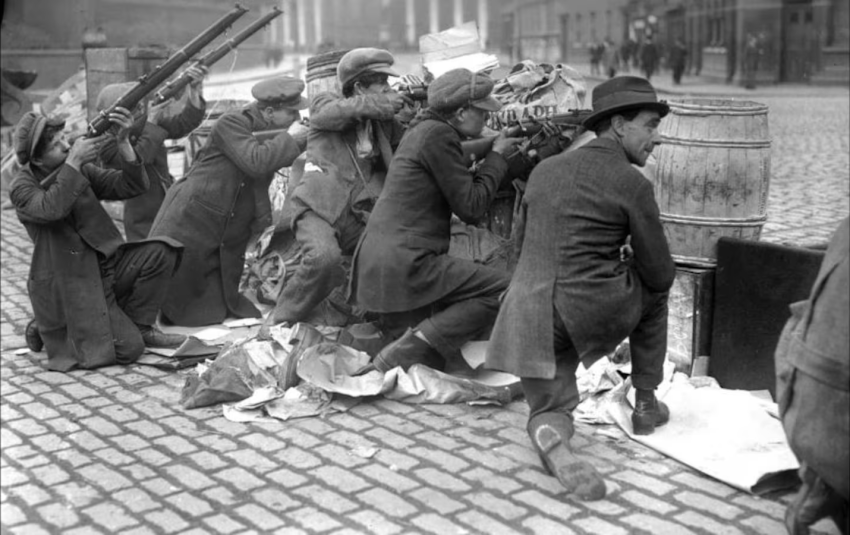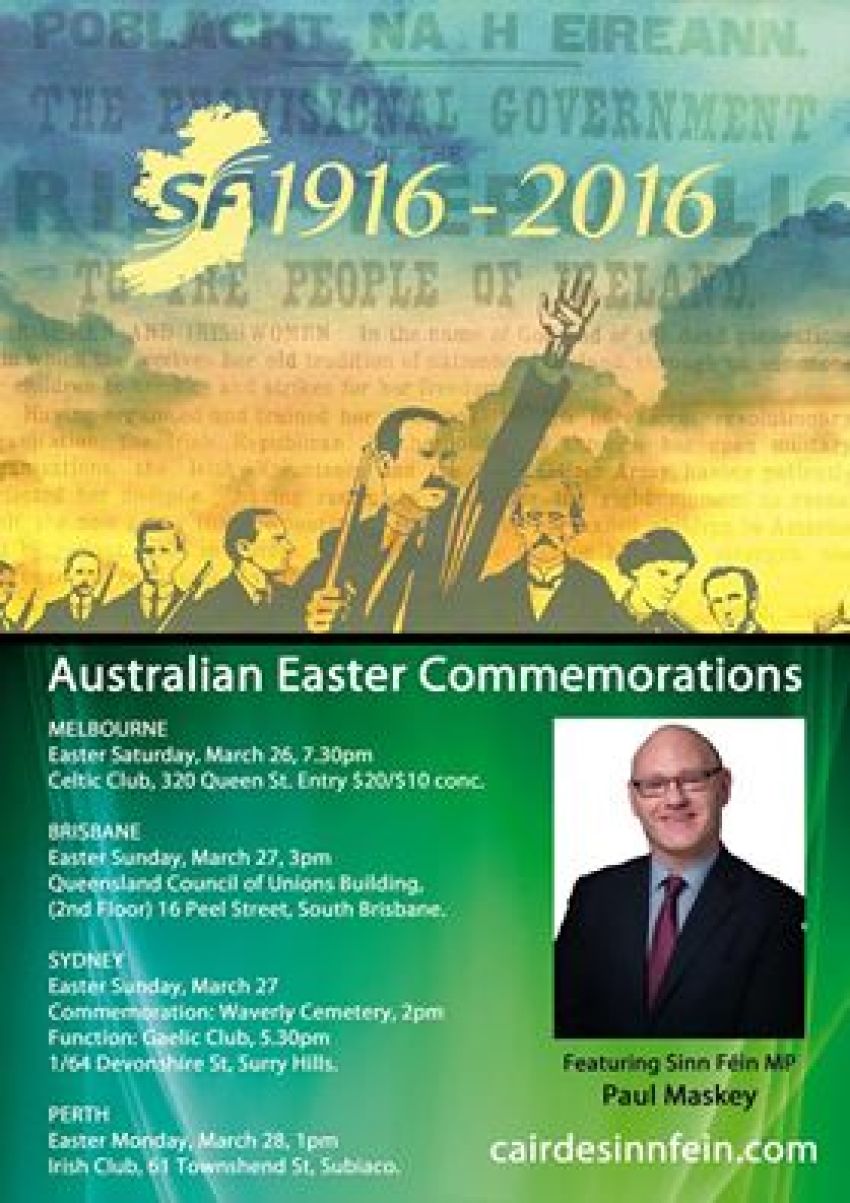
This Easter marks 100 years since Ireland's Easter Rising, when republicans launched an armed insurrection against British rule. Seizing Dublin's General Post Office, the rebels proclaimed an Irish republic based on the principles of freedom and equality.
But more than simply a bid to win Irish freedom, the Easter Rising was launched to strike a blow at the British Crown as it sacrificed endless thousands of young men in a futile war.
It is impossible to separate the rising from the industrial-scale carnage raging in Europe, with 17 million people ultimately killed in Word War I.
Britain was increasingly seeking to draw Irish people into the bloody conflict, stepping up recruiting efforts among young Irish men — many of whom joined to escape poverty — while threatening to impose conscription on the island.
As Irish rebel song about the Rising, "The Foggy Dew", declares: “It was better to die 'neath an Irish sky than at Suvla or Sud el-Bar”.
British forces responded decisively to the rising. The fighting between Crown forces and the rebels — made up of armed contingents from the Irish Republican Brotherhood (IRB), an underground revolutionary group, and the Irish Citizen Army (ICA), a smaller, socialist-led workers' militia, held out from Easter Monday for a week.
When British “law and order” was restored, it came with savage retribution. Taken by surprise by the secretly prepared rising, much of Ireland's population was indifferent or hostile to the rising.
But British repression, in which all seven signatories to the independence proclamation and eight others were executed and thousands more arrested, swung public opinion behind the republican cause.
Spark for new struggles
Although defeated, the rising was the spark for a new wave of struggle for national liberation. In 1918, candidates for the republican party Sinn Fein won a majority of Irish seats in elections to the British parliament. Refusing to take their seats, the Sinn Fein MPs instead declared independence.
This began the war of independence between the Irish Republican Army and British forces and local proxies that ended with a controversial treaty that partitioned Ireland. An Irish “free state” was formed in 26 of Ireland's 32 counties, but Britain kept control over six counties in the north — which it still claims to this day.
This sparked a bitter civil war, with many feeling that their dreams of an Irish republic based on justice and equality had been betrayed. Partition created a northern statelet with an artificially created pro-British Protestant majority enjoying privileges over the largely Irish nationalist Catholic minority. This led directly to the horror of the Troubles that broke out in the late '60s, and killed thousands in subsequent decades.
The rising was clearly a response to British oppression of Ireland, which dates back more than 800 years. Opposition to British rule meant much more than preferring a parliament in Dublin to one in London.
British rule, in which Ireland's land and industry were geared towards serving the interests of English landlords and capitalists, was genocidal. A manufactured famine in the mid-19th century combined with attempts to wipe out the Irish language, culture and identity.
But the role of World War I, and the determination to strike a blow against it, cannot be ignored in accounts of what drove the rising — especially its timing, which its defeat suggests was launched prematurely.
Video: The Easter Rising 1916 (real footage of aftermath). worcesterjonny.
World War I
The most politically advanced leader of the rising was the veteran socialist James Connolly, commander of the Dublin Brigade of rebel forces that led the Easter fighting.
His participation in the rising was explicitly bound up with his opposition to World War I and his determination to strike a blow against a major belligerent in what he denounced as a “capitalist war”.
Connolly had been a leader in the trade union and socialist movements in Scotland, Ireland and the United States (where he was active in the Industrial Workers of the World).
Never a narrow Irish nationalist, he supported Irish liberation from English rule — but insisted that only a socialist republic would bring true freedom to Ireland's working majority.
Connolly's role was as a leader of the ICA, a workers' self-defence militia formed by trade union volunteers in 1913 to counter police violence against strikers.
Connolly is a much-hailed hero in Ireland, and it is not hard to see why. Military leader of the rebels, he was famously shot in the ankle during “Easter week”, but continued to command rebel forces from his stretcher.
Sentenced to death by the British, his injuries meant he could not stand to face the firing squad, so authorities infamously strapped him to a chair before shooting him dead on May 12.
But while Connolly's bravery, and Britain's cruelty, made him a hero, the content of his politics as a revolutionary socialist are often sidelined.
James Connolly
He was one of the greatest figures produced by the post-Marx, pre-1917 socialist movement. He made enormous ground in developing an understanding of the relationship between the national struggle for Irish independence and the Irish class struggle.
Committed to the cause of international socialism, Connolly viewed World War I as the greatest horror in the world at the time. Once it broke out in 1914, his entire political perspective and actions were shaped by a burning need to strike a blow against it.
C Desmond Greaves, in his 1961 The Life and Times of James Connolly, describes Connolly's attitudes while he was in Belfast, in the early stages of the war.
Connolly's attempts to campaign against the war were criticised by other members of the Independent Labour Party Belfast branch, who wanted him to focus on “bread and butter issues”.
Connolly responded: “They seem to have a curious idea of what constitutes working-class propaganda. They don't seem to think I ought to express an opinion on the greatest crisis that has faced the working class in our generation.”
Connolly concluded that the sheer scale of the horror of the war required a revolutionary response.
Greaves wrote that when Connolly, sitting in his Belfast office, was brought news of the outbreak of the war, he “sat for a long time silent, head in hands. Finally, he announced emphatically that a blow for Irish independence must be struck.”
Connolly had drawn the same basic conclusion as the Russian revolutionary Vladimir Lenin — who famously declared that the “imperialist war” had to be “turned into a civil war”.

In the March 1915 International Socialist Review Connolly wrote: “The signal of war ought to have been a signal of rebellion … for social revolution … Such a civil war would not have entailed such a loss of socialist life as this international war has entailed.”
In an article in the Irish Worker arguing for an Irish rising against British rule, Connolly said: “Starting thus, Ireland may yet set the torch to a European conflagration that will not burn out until the last throne and the last capitalist bond and debenture will be shrivelled on the funeral pyre of the last warlord.”
Connolly was not alone in thinking the war meant the time had come for a new rebellion against British rule. Republicans in the IRB, which operated secretly within the broader nationalist Irish Volunteers group, had decided World War I was an opportunity for a fresh Irish rising and had begun working to this end.
However, the IRB's conspiratorial approach was very different to that pursued by Connolly. A veteran street activist, Connolly used open agitation to make his case for a mass rising.
Fearing that Connolly's open agitation threatened their secret plans, the IRB drew Connolly into their own preparations.
Despite disagreeing with the conspiratorial approach of the IRB and preferring more mass involvement, Connolly agreed to join the plot — believing an imperfect rising was preferable to none at all. With the horror unfolding in Europe, the most important thing needed was to raise the flag of revolution.
For various reasons, a series of things went wrong in the lead up to the rising. Despite the fact it seemed doomed, the leaders went ahead, preferring to go down fighting than accept the status quo. Greaves tells the story of a comrade who ran into a whistling Connolly on the morning the rising began and, asking him how he thought it would go, was met with the cheerful response: “We're all going out to get slaughtered.”
This response was not driven by a death wish, but by the knowledge that, whatever the odds against a victory in their rising, the rebels' actions were essential — it would be the first revolutionary rising against the carnage of World War I and would declare to the world that the Irish people would not accept their bondage.
Legacy
Lenin, who a year-and-a-half later would lead the world's first victorious socialist revolution in Russia, hailed the rising as “a blow delivered against the power of the English imperialist bourgeoisie by a rebellion in Ireland is a hundred times more significant politically than a blow of equal force delivered in Asia or in Africa”.
One hundred years on, Ireland remains a long way from the principles of the proclamation. Working people are suffering from harsh austerity imposed by Britain and local elites on behalf of European institutions in the south. But a huge social movement against water charges in Ireland's south shows the spirit of rebellion is alive and well.
Globally, the world still mired in war and poverty — and threatened by the unprecedented horrors of climate change — the boldness and determination of those who rose in Ireland in 1916 is needed more than ever.
[The 100th anniversary of the rising will be commemorated across the country. See here for details.]
Video: Young Dubliners Foggy Dew. lorddeath31.
'So hold on to your rifles, boys, don't give up your dreams Of a Republic for the workin' class, economic liberty'